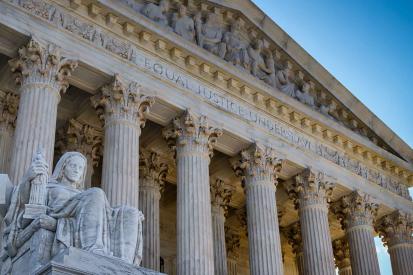The End of the Lemon Test


One of the biggest obstacles to religious liberty that I have seen in my years litigating First Amendment cases since 1984 has been the extreme separationist version of the Establishment Clause manifested in the Lemon Test, a three-part test concocted by the Supreme Court in the 1971 decision Lemon v. Kurtzman. Its ahistorical focus and one-size-fits-all application convinced many government officials that they had a constitutional duty to go on search-and-destroy missions to obliterate all things religious from public life. Thank God the Supreme Court finally eliminated this destructive test in June 2022 in the Coach Kennedy prayer case, Kennedy v. Bremerton School District.
Of course, in 1789, the First Congress placed the Establishment Clause in the text of the First Amendment: “Congress shall make no law respecting an establishment of religion, or prohibiting the free exercise thereof.” (The term “separation of church and state,” or anything like it, does not appear in the Constitution).
At the time Congress proposed the Establishment Clause, Americans and Europeans were familiar with established state churches and how they used the coercive power of the state to compel people to participate in their religious orthodoxy. State churches, as Stanford Law Prof. Michael McConnell explains, exerted their authority by controlling the doctrine and personnel of the state church, mandating attendance at the services of the state church, giving financial support to the state church, restricting the worship of dissenting churches and prohibiting government offices to dissenters, and using the state church to carry out certain civil functions.
ADF attorney Brett Harvey refers to this as the “force and funds” view of the Establishment Clause, using a phrase first used by the United States government in a brief it filed in 1992 in Lee v. Weisman. That is generally what people at the time thought they were doing by ratifying the Establishment Clause—prohibiting the federal government from using its “force and funds” to support an official church.
The Lemon Test
In 1971, the Supreme Court devised a new test for evaluating government actions that might violate the Establishment Clause—the Lemon test. The test comes from the name of the case, Lemon v. Kurtzman. The justices tried to create with the Lemon test a grand unified test to resolve every case arising under the Establishment Clause, whether it involved private religious speech, legislative prayer, government funding that flows to religious groups, passive religious displays, etc.
Under the Lemon test, a government action violates the Establishment Clause if it violates one or more of its three prongs:
- lacks a secular purpose;
- has the primary effect of promoting or disparaging religion;
- excessively entangles the government in religion
The Supreme Court in the Coach Kennedy prayer case in June 2022 finally announced what many had suspected for years—it had abandoned the Lemon test. Instead, courts will now look to “historical practices and understandings” to determine whether the government’s actions violate the Establishment Clause.
The Lemon Test conflicts with history
One of the most glaring examples of this conflict between the Lemon Test and historical practices at the time of the Establishment Clause’s ratification came in the 1983 Supreme Court case Marsh v. Chambers. A legislator challenged the Nebraska Legislature’s practice of hiring a chaplain to open sessions with prayer.
This practice would have a tough time surviving the Lemon Test, yet the Supreme Court upheld the practice 6-3. Why? Because three days after the First Congress set up its paid chaplaincy, it approved the text of the First Amendment, including the Establishment Clause. This powerful historical evidence convinced six justices in Marsh to ignore the Lemon Test and uphold the practice of legislative prayer, because “the men who wrote the First Amendment Religion Clauses did not view paid legislative chaplains and opening prayers as a violation of that Amendment.”
The Lemon Test has been used to censor private religious speech
Government officials have used the Lemon Test to justify censorship of private religious expression, although the test does not do so. The Constitution, including the Establishment Clause, only restricts the actions of the government, not private individuals or institutions. Yet, many government officials interpreted Lemon’s endorsement test to command them to purge religious expression from the public square.
The Supreme Court has repeatedly rejected this argument, yet the religious censorship persists. Shurtleff v. City of Boston, decided in May 2022, is the sixth case since 1981 where the Supreme Court has said that the Establishment Clause does not require government censorship of private religious speech—Widmar (1981) Mergens (1990), Lamb’s Chapel (1993), Rosenberger (1995) and Good News Club (2001). Even after these five decisions stretching back to 1981 rejecting the argument, Boston still asserted that the Establishment Clause required it to reject the flying of the Christian flag, and the Supreme Court had to reject that wrong thinking once again.
ADF experienced this argument when it challenged the New York City Department of Education’s ban on religious worship services in New York City public schools during non-school hours. ADF fought this case over a 20-year period (1995-2015). New York City public schools allowed private groups and individuals to use vacant buildings during non-school hours for any purpose “pertaining to the welfare of the community,” but banned religious worship services. ADF challenged the policy on behalf of a small church in a poor neighborhood, Bronx Household of Faith.
Although the federal appeals court admitted that the Lemon Test did not require this policy, the Court nonetheless upheld the policy because New York City could consider Establishment Clause “concerns” to justify excluding worship services. Mayor Bill de Blasio finally ended this discriminatory policy in 2015. It was a result of the Lemon test, whose bitter fruit the Supreme Court has now buried.
Conclusion
The end of the Lemon test will restore right understanding of the Establishment Clause—the government cannot force people to participate in or provide direct financial support for religious activities. The demise of the Lemon test will stop the singling out of religious groups and individuals for governmental exclusion or censorship simply because they are religious.

